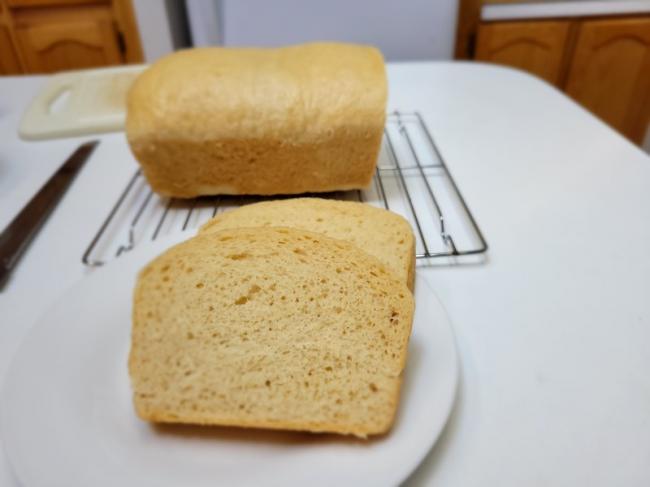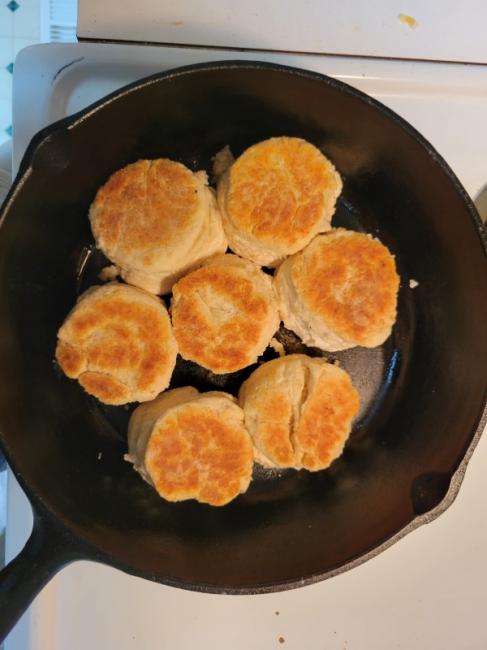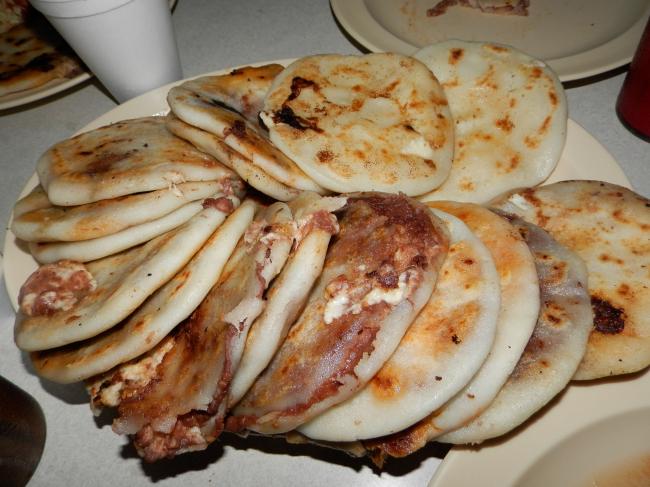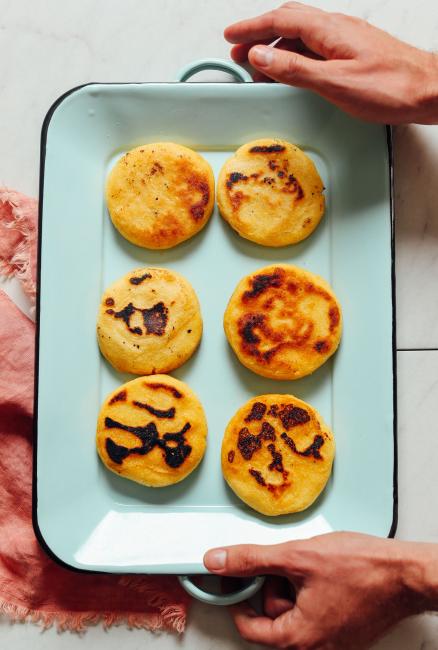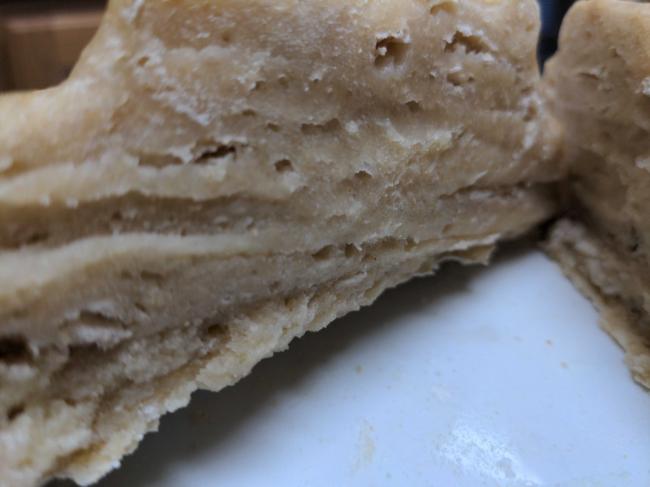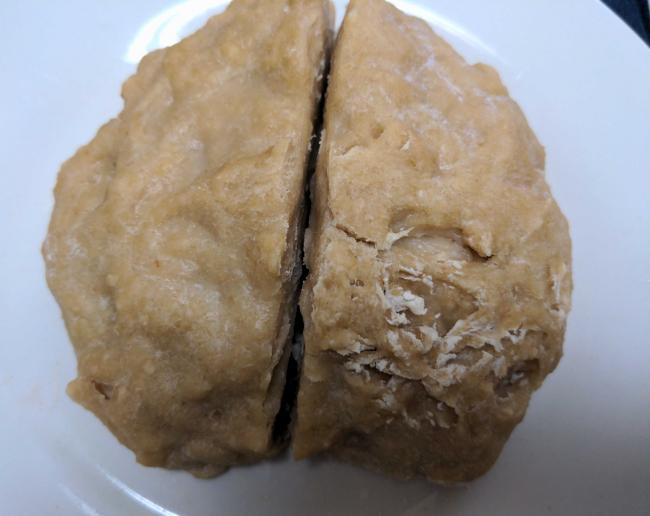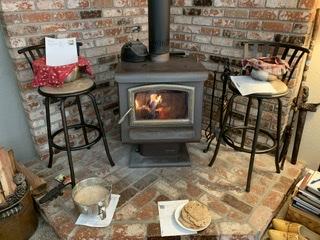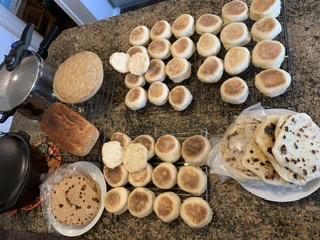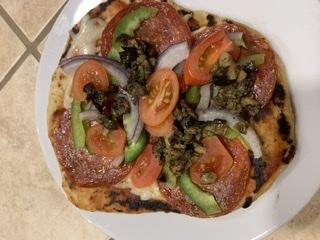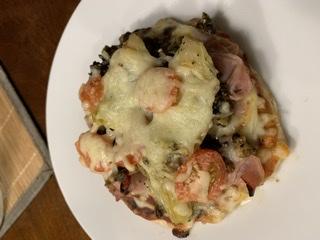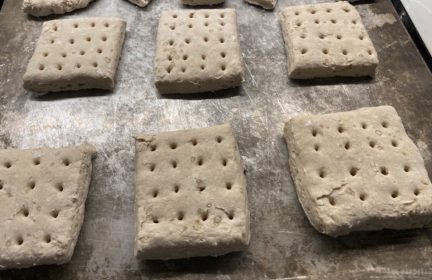Learning to bake without an oven – some suggestions
One of the standard items in food storage is lots of flour or wheat for grinding. I was thinking the other day, “Great, I have all this flour, the power goes out, I have no oven, it’s howling and sleeting outdoors. What am I supposed to do with all this flour?”
So I’ve been keeping extremely amused, learning how to circumvent the need for an electric oven to bake – INSIDE – not outside where the usual utensils; Dutch oven, barbecue, grill, campfire, propane cooktop can pick up the slack in a power outage that occurs in fine weather.
So far, I have learned how to steam muffins, pressure cook yeast bread, fry corn pone and “bake” biscuits in the skillet. I suppose a pan of cornbread is next on the list. My chief taste tester says I must continue to hone my skills as he’s more than willing to keep his job!
It will be awhile before wood stove weather arrives and I can test my new skills on a less steady source of heat than my electric stove top. However, I’m finding that I don’t need nearly as much heat to bake these goodies as I would have thought. Top picture, pressure cooker yeast bread, bottom picture skillet biscuits.
-
Comments (47)
-
Carlotta SusannaStaff - November 2, 2021
This is a great topic! I’ve never tried any of the methods you’ve listed – do you by any chance have any links to your favorite recipes?
P.S. I slightly modified the title to make sure it’s clear you’re not asking for advice etc. Hope that’s ok.
-
Barb LeeContributor - November 2, 2021
Hi Carlotta Susanna,
First, I greatly appreciate all the work that Staff puts in to make this such a high quality and enjoyable forum!
I’ve tried to answer this about six times, but many times when I go to look up one of my links, I forget to open a new tab and lose everything I’ve typed! LOL! So let me try to get the links up first:
Corn pone: https://preparednessadvice.com/corn-pone-pioneer-stable/
Steamed Bread: https://www.breadexperience.com/steamed-bread/?doing_wp_cron=1635443829.5168011188507080078125
Pressure Cooker Yeast Bread: https://www.instructables.com/Easy-Bread-Anywhere:-%22Baking%22-bread-in-a-pressure-/
Skillet Biscuits: https://www.food.com/recipe/stove-top-biscuits-484455
English Muffins (not tried): https://www.allrecipes.com/recipe/6947/english-muffins/
I also want to try some version of cornbread, either pressure cooked or steamed.
A couple of important notes about skillet biscuits. I use cast iron, but understand that cast iron heats very unevenly. A tip I found is to rotate the skillet over the heat source periodically, as one would a Dutch oven over coals. Additionally, my newer Lodge skillet heats much more efficiently than an old no-name skillet with walls of obviously uneven thickness. I actually used an infrared heat tracer to detect the surface temperature of the skillets and the variations on the old skillet were wild!
The other neat tip is learning the temperature at which your cooking oil/fat smokes. If you use one of the fats that smokes at 350 to 370, adjust the heat under the skillet so that the fat does not smoke. The reward is golden biscuits! Let me see if I can get this last link right: https://www.thespruceeats.com/smoking-points-of-fats-and-oils-1328753
My “trial by fire” will come when it’s time to light the wood stove and the heat is not so easily regulated, but the learning, the experimenting and the tasting is really fun!
-
Carlotta SusannaStaff - November 2, 2021
Thanks for the kind words – shared with the team, it really means a lot to us 🙂
And sorry about your struggles lol but this is really appreciated, thanks for taking the time. And the extra tips are priceless. I’m curious about trying the Corn pone – never had one in my life! I assume they’re good with anything savory?
p.s. I hope you don’t mind I boldened the names of the recipes so they pop up easily when scanning the post.
-
Barb LeeContributor - November 2, 2021
Corn pone dates back to probably well before the Civil War and you can tell that this recipe was for putting something in empty bellies when not much else was available…kind of like hard tack, I imagine. It was important during the Great Depression. There are many, many modernized revisions of this recipe that sound more like corn bread to me. The start of this whole experiment was looking for a recipe that might produce something near to what my mother learned to make for my southern dad. I used to love it as a little kid, so it was just a trip down memory lane on a rainy day. A dinner with corn pone in my childhood consisted of pinto beans and fried ‘taters. It may be an acquired taste! LOL! I think they’d be fabulous slathered with guacamole!
The trick is getting the dough consistency right, as this version has nothing to bind it, like egg. The author’s note about pushing three fingers (lengthwise) into the dough validated the recipe for me. I can visualize the imprint of my mother’s three fingers across the top of the pone.
-
Bob - November 2, 2021
Good evening Dogpatch,
Had read of a Confederate Army food called “Confederate shortbread”.
It was a white corn bread made over a camp fire.
The Confederacy had no access to wheat due the USN’s blockade of the Confederate ports and small landings.
For preppers, it could be valuable to read up on historical examples of getting food ingredients and preparing them.
Acorn flour just won’t work unless the cook knows how to make it into a desirable food.
Those pictures of the bread products were real nice and got me yearning for real homemade bread.
-
Barb LeeContributor - November 2, 2021
Hello Bob, of course I had to look up Confederate shortbread. It’s hard to know when an “historical” recipe hasn’t been vandalized to make it tasty to modern palates.
I think the link I provided is the one that states that corn pone was eaten by both the north and south armies.
I believe that a lot of people died in the south due to the niacin deficiecny disease pellagra. Apparently this was because of their reliance on corn, in which niacin is tied up. Native north and central American people learned to treat corn with an alkali (basically lye made with wood ashes and water) which released the niacin. These people never suffered the pellagra that was prevalent in the south.
My dad was a Depression kid, by all accounts, from an improverished Arkansas farm family, so corn pone, pinto beans and fried potatoes were a sort of survival food for him, but they were also “native” foods, including his #1 staple, biscuits, which he couldn’t live without when he escaped that grinding poverty. We’d have to scrutinize the origins of those foods before we really came to depend on them for survival. But that’s what they are, in their most raw element; survival foods.
-
Bob - November 3, 2021
Good morning Dogpatch,
This is fascinating, especially re the link to pellagra/corn.
Here, too, parents were products of the depression. “Going fishing” was not an expression involving recreation.
Just saw in one of my Civil War file folders the Confederate Army song re goober peas. We now know then as peanuts. You’re right that the historic foods are probably not the same as today. I had some peanuts when working in Indonesia and it would take about 4-5 for the same volumn of peanut available in a grocery store.
-
Barb LeeContributor - November 3, 2021
My dad used to sing snippets of that song. Memories…
One can buy corn flour (not meal) that has been “nixtamalized” – given the alkali bath – in the form of masa harina. It is easily available in our area. Very fragrant, and associated with Latin American dishes. Hominy is the whole kernel product. Hominy grits would, I guess be somewhat the equivalent of untreated corn meal. Grits are not common in our region but maybe something to look at for storage, since they would supposedly provide the niacin that untreated corn meal does not. Must…look…for…grits at the store today.
-
Henry Tubbs - November 3, 2021
For some non-vandalized historical recipes, check out the YouTube channel Townsends. They take recipes from 18th century books and make them using technologies that would have been available to people at that time.
I made ‘The simplest apple pie ever‘ from his video and it turned out pretty good. Definitely not as sweet or flavorful as a modern day version like you said though.
-
Carlotta SusannaStaff - November 3, 2021
Now it occurred to me that the corn pone reminded me of Papusas – have you folks ever had them? They’re delicious.
They are Central American (Mexican, Salvadoran, Guatemalan – depending on who you ask). They are made of cornmeal or rice flour, they are often filled with something, and they are pan-fried. I’d imagine that they’d be edible even without the filling.
-
Carlotta SusannaStaff - November 3, 2021
Actually similar, are Arepas, although they don’t usually come with fillings.
-
Barb LeeContributor - November 3, 2021
These recipes look amazing! I am so glad we are collecting all this wonderful information on one site and post! I have got a dreary winter to look forward to and I am going to become a master oven-free baker! LOL!
-
Alicia - November 4, 2021
Papusas are amazing! Totally can second that one.
+1 on the fascinating info on the nixtamalization benefits and pellagra.
-
-
JennyWren - November 3, 2021
May I suggest you try No oven bread rolls I’ve made these myself and they are very good with soups and stews. It’s a go-to recipe of mine when I’m camping. You end up with something similar to what we call ‘oven bottom rolls’
-
Barb LeeContributor - November 3, 2021
JennyWren, THANK YOU for that link! I am looking forward to trying it!
-
-
RedneckContributor - November 3, 2021
What am I supposed to do with all this flour?
Don’t forget pancakes & tortillas. Since wheat berries are my largest store, by far, I’m prepared to use them. I keep lots of baking powder & baking soda in storage too.
The wheat berries themselves can be boiled & used in various recipes, including as breakfast food.
-
Robert LarsonContributor - November 3, 2021
I’m always looking for my next preparedness challenge, and I think I’ve just found it! Maybe I’m just hungry, but I want to learn how to make different breads without an oven now. Thanks for the idea.
I will update if I try any recipes.
-
GB - November 3, 2021
Hi Dogpatch,
As a kid learning about early European settlement, we were introduced to the wonder that is damper. Using only three shelf-stable ingredients, an open fire and a camp oven, you can fill out a small meal quite easily. A how-to is here.
As an adult, I have learned that indigenous Australians made a similar bread using flour ground from native seed. An example of damper making is on this website, from Western Australia.
(This is not the place to comment on the school curriculum when I was growing up, but suffice to say, on indigenous matters, it was…severely lacking…)
If you want to get fancy, there are PLENTY of recipes to be found across the interwebz.
-
Barb LeeContributor - November 3, 2021
Hi GB! I learned about damper from an Australian acquaintance around 2000. I didn’t include it here because his version required a “camp” (Dutch) oven. Boy did I get razzed when I used the familiar US name “Dutch oven”! His version of damper was flour, salt and water, maybe some chunked up cheese and essentially, raw bacon. It was a big hit with those Americans to whom he introduced it on his visit here.
-
GB - November 3, 2021
Hi Dogpatch,
Yup, the term “dutch oven” has a completely different meaning in the vernacular over here! 😀
I wasn’t sure what kind of set up you had re: wood burner. If you have a wood fired stove, you could pop the camp oven on the top, add some coals from the fire on top and try to cook it that way.
As long as the damper is surrounded by heat, you could probably make it quite easily. Having said that, I never would have thought you could make successful scones (biscuits) on a stove top for the same reason, and I’m glad you’ve proven me wrong!
-
Barb LeeContributor - November 3, 2021
Hey GB,
I’ve got a number of outdoor cooking options in a power outage, but most of our outages take place in really dreadful weather, where the LAST thing I want to do is cook outdoors. This past February, we had a freak ice storm that took out the power for 8 days. That is not a time when I’d be wanting to cook outdoors! It was great for shoveling bunches of ice into “eskies” when the refrigerators proved too unstable to maintain safe temperatures even with occasional shots of electricity from a generator. For such a “short” period of time, baking wasn’t necessary, but in the spirit of the thing, it would’ve been fun. We have a wood heating stove with a flat surface large enough to do some cooking, but I never imagined baking to be a possibility without taking it outdoors.
I know a lot of people feel that by taking certain precautions, one can cook indoors on a propane camp stove, but I tend to take cautions about things like that very seriously so beyond brewing a pot of coffee, I am afraid to use one indoors, and wouldn’t consider coals from a wood burning stove indoors.
Tomorrow I will be receiving a little folding camp oven that’s designed to be used on a propane camp stove. I will be experimenting with it once it gets cold enough to fire up the wood heating stove.
-
Robert LarsonContributor - November 4, 2021
GB – That damper recipe looks exactly what I wanted to make. Three simple ingredients, and no waiting hours for the bread to rise.
I followed the instructions exactly on that website, but used my oven instead of coals. I know… I know… This is a page about learning to bake without an oven. I just wanted to see if it would work though.
What I got after 30 minutes at 350 degrees and 20 more minutes at 400 degrees is this lump of dense dough that doesn’t looked cooked at all. Any suggestions? I am horrible at baking.
Kinda looks like a brain after I cut it in half, doesn’t it?
-
RedneckContributor - November 4, 2021
I’d have to be mighty hungry to eat that. 🙂
Why don’t you try making tortillas? Flat breads are much easier.
-
Robert LarsonContributor - November 4, 2021
I just ate half with some jam and it was like eating a solid ball of gluten. My jaw hurts now from so much chewing… The other half unfortunately is going to get tossed, it’s not worth eating. But that’s why we practice BEFORE the disaster right!? To get our recipes down so we aren’t eating balls that resemble Play-Doh.
My favorite flat bread is the Indian naan bread. That must be the only bread served up in heaven because that’s what it is, heavenly.
-
Barb LeeContributor - November 4, 2021
Robert, that’s exactly what the “authentic” damper we were introduced to looked like. though maybe it was a little more browned on the outside.
-
Robert LarsonContributor - November 4, 2021
Thanks for your input Dogpatch. So much for this recipe. Like Redneck said, you have to be pretty hungry to eat this.
I’ll try another recipe on this thread here soon. Maybe some rolls or tortillas.
-
Barb LeeContributor - November 4, 2021
Pita bread is another one that can be baked either in an oven or on a hot griddle.
The “damper” we found in Australian restaurants was definately “palate-ablized” into something much more like ordinary bread.
-
GB - November 5, 2021
Hi Dogpatch and Robert,
No doubt the restaurant used loads of good stuff like yeast, or another raising agent, and butter. The only time I made damper was when I was in school, so I am as far from expert as can be! I’m sorry if I gave the impression I was.
I’m unsure why your bread didn’t even brown up, Robert. Maybe the website used a sneaky milk wash before baking for marketing purposes… I have read that the batter needs to be worked as little as possible and if you try traditional oven baking, you need the oven initially at 200C (~390F), then drop it to 180C (~350F) for the last 10min.
Lebanese flatbread (which I think is a thinner bread, but served in larger sizes to pita bread) is another option for bread cooked on a flat plate or pan. My personal favourite is Turkish gozleme, filled with spinach and feta, drizzled with lemon juice after it’s cooked. Hmmm, feeling hungry now…
-
Robert LarsonContributor - November 5, 2021
Thanks for your thoughts on the damper. I’ll have to experiment and play around with it.
-
JennyWren - November 7, 2021
I think you may have answered a thought I had while reading the OP. How would outdoor cooking styles and recipes work indoors?
I doubt you are that bad a cook to come up with a bread brain, so maybe there is something to be said about having heat at least top and bottom. I think an experiment of my own is in order. I never made damper so this could be an experience!
I have to admit, I would probably stick with smaller or thinner types of breads that cook fairly quickly.
Ooo, I’ve just thought of a couple of other types Frybread and Langos. I think we all know frybread, but Langos are a variation on a theme of frybread, you use a yeasted dough and roll out to a similar thickness to frybread and well fry! The result is a light billowy disc that tastes like a savoury doughnut.
-
-
JennyWren - November 5, 2021
And if you want something sweet and cakey, Welsh Cakes are the bits.
I have made thousands of these over the years, varied them with a bit of mixed spice or changed the fruit, even left the fruit and sugar out for a savoury version to go on the cheeseboard.
The climate is too cool and the summer too short to grow corn over here so cornmeal is an imported luxury. To utilise the grains that we grow, the local delicacy are Staffordshire Oatcakes Oh boy! these are food of the Gods designed to enlarge the waistline of us Stokies. Best served with cheese and bacon. I’m dribbling.
-
Barb LeeContributor - November 5, 2021
JennyWren, will be having Staffordshire Oatcakes for breakfast this morning! Thanks for the recipes!
-
-
JennyWren - November 7, 2021
Well, if I wasn’t so stressed out about it, this week would be a perfect time to test out a few of these ideas. I’m having a new kitchen fitted and will be without the usual luxuries for a week. The microwave is on standby
-
Gideon ParkerStaff - November 7, 2021
That sounds exciting! I hope the new kitchen turns out well.
-
JennyWren - November 7, 2021
This will be the first kitchen designed around me, Gideon. I’m future proofing it, no wall cupboards, oven at eye height and all the lower units bar two are fitted with drawers. (no more bending down or rummaging on my hands and knees!) Growing old sucks, but I consider myself fortunate to be able to do this to make life easier now and in the future.
-
Alicia - November 16, 2021
We remodeled our kitchen 6 or so years ago. Totally worth getting the design for you. Was over budget and schedule, but still so glad we did it. In addition to drawers, I can recommend more power outlets than code dictates. I mapped out where things would be stored on the counters and added outlets behind the appliances and in the open ‘edge’ spots so I didn’t have to move items to plug in the spice grinder.
-
JennyWren - November 17, 2021
We did the same Alicia. We have a pull out larder cupboard fitted as well. Oh my word! That on it’s own is worth the money! Yes we have over spent and yes again it’s over schedule, but I can live with that.
What was nothing short of a badly designed glory hole with nowhere to put anything is now a haven of efficiency, space and more storage than you can shake a stick at!
-
Alicia - November 20, 2021
Oh YES! the only frustration with ours is that they don’t actually fully extend like the drawers. There’s about 1″ of overlap which means I can’t lift up the back items without adjustment. Grrrr. They should have used over-extension drawer slides which are only slightly more expensive vs. my replacing them all now. And they told me the doors couldn’t be soft close because the hinge – $3 and 30 seconds later, they were. The cabinet crew (including the boss) was amazed and this is their business. sheesh.
-
-
Thekaren - November 14, 2021
-
Barb LeeContributor - November 14, 2021
Thank you for these new links!
-
CR - November 22, 2021
Dogpatch, I got inspired by you to do some trials! With SIL’s assistance we made Indian Chapati, Naan, English Muffins, and a No Knead bread I’d made before, all double batches in a 7 hour marathon.
Top pic shows our trial space for dough raising in warm temps, which worked great.
The pale, unappetizing loaf was done in pressure cooker, dark one in Dutch oven, and all others on cast iron griddle or frying pan on stovetop. Lots of yummy breads that individually were pretty easy, we just got tired doing so many in one day. The Naan & English muffins are the tastiest of the ones we did.
Thanks for the ideas & recipes!
-
Barb LeeContributor - November 23, 2021
Wow! Talk about takin’ it and runnin’ with it! What a beautiful spread!
-
Robert LarsonContributor - November 23, 2021
That looks so good! I’ve never made english muffins before so that may be next on my baking list.
-
GB - November 23, 2021
What a mammoth effort CR!
They all look so good. I want a muffin now, dripping with butter and a very slight smear of vegemite… nom nom.
-
CR - November 24, 2021
We did further experiment of using the finished Naan as pizza foundation, then cooked on smoker grill, and that was especially delicious!
Also, the ugly pressure cooked loaf turned out to be a tasty, dense, & moist 1/2 whole wheat bread with good crumb, so despite pallid appearance I would certainly make it again.
-
-
Estel - November 24, 2021
I lived for one year in a place without an oven. I got in the habit of cooking quick-bread biscuits in a frying pan on the stove. (I had a recipe in one of my cookbooks for stove-top biscuits, so I wasn’t making up the process for this one.)
A few years later, I was baking a special seasonal yeast bread. I’d made the dough, shaped it into loaves, turned on the oven, and discovered the oven was not working. I didn’t want to waste the dough, so I rolled it out and cut it into rounds, buttered the bottom of a frying pan, and cooked the rounds on the stove in the frying pan with a lid on – a bit of time on one side, then turned them over and cooked a bit on the other side. They came out great, definitely tasted like the seasonal bread they were supposed to be, even if not in the traditional shape.
-
Barb LeeContributor - November 24, 2021
Love it! Optimal use of resources!
-
-
- News for the week of 2025-07-07 - 2 days ago
- Fun ways to teach kids outdoor/survival skills - 1 week ago
- News for the week of 2025-06-30 - 1 week ago
- News for the week of 2025-06-23 - 2 weeks ago
- News for the week of 2025-06-16 - 3 weeks ago
This forum is heavily moderated to keep things valuable to as many people as possible. Full community policies are here. The basics:
- 1. Be nice to each other.
- 2. Stay focused on prepping.
- 3. Avoid politics, religion, and other arguments.
- 4. No unfounded conspiracies, fake news, etc.
- 5. Debate ideas, not people.
